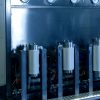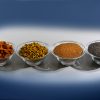Our experience with supercritical CO2
The extraction of high added value products from vegetable matrices and the request for a green process has led Exenia to develop the supercritical CO2 extraction process over the years. CO2 or carbon dioxide is normally a gas, however if it reaches very precise pressure (73.8 bar) and temperature (31 ° C / 304.1K) values it is in the supercritical state, where it is viscous as a gas and with a density comparable to that of a liquid.
In this state, CO2 becomes a non-polar solvent, such as hexane or toluene which are often used for extractions, but which are toxic to humans and the environment. Over the years, Exenia has developed various industrial processes to use supercritical CO2 as a solvent: research has been carried out on various types of matrices, from seeds to extract oil, to waste products from the food industry such as processing waste rice, the wine supply chain or the tomato supply chain, to extract molecules with high added value.
Extractions of aromas (e.g. vanillin), fragrances (e.g. rose perfume), essential oils (e.g. basil, thyme etc.) have been developed. Applications have been developed for the food, cosmetic, pharmaceutical and nutraceutical industries.
All these experiences have also allowed the company to verticalise the technological application by also developing supercritical and subcritical CO2 micronization to obtain more bioavailable compounds and the pasteurization of liquids such as fruit juices to obtain complete deactivation of the bacterial load by the Supercritical CO2 at room temperature (30° C).


